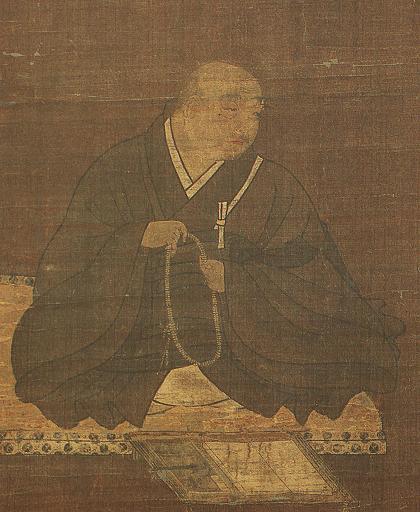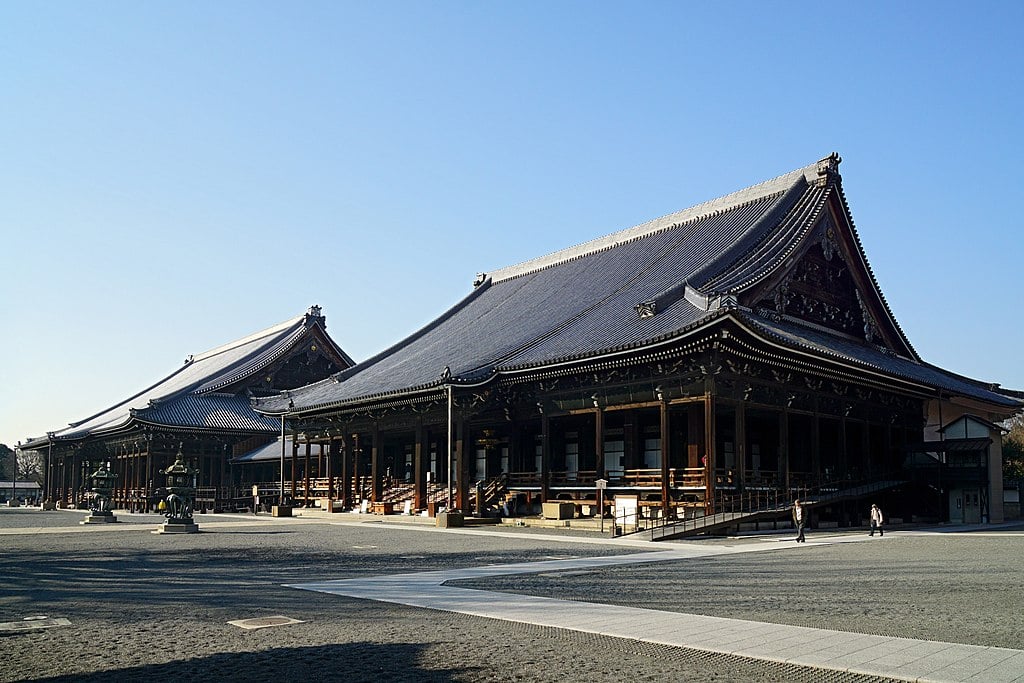Shinran was only thirty-four when the emperor’s ban on reciting the nenbutsu put an end to his training with Honen, as they were exiled to different parts of Japan. And he was thirty-nine when Honen died. So we cannot know whether Honen would have agreed with Shinran’s development of his ideas. But Honen’s disciples did not agree, and Shinran’s disciples had to set up a different school, the Jodo Shinshu school.
Kasulis identifies four points of divergence in Shinran’s conclusions as compared to Honen’s: “1) the radicalization of the distinction between own-power and other-power; 2) the change in the meaning of the nenbutsu; 3) the de-emphasis on the deathbed visitation; 4) the dehistoricizing of tradition.” Shinran’s goal was to ensure that his practice “contained absolutely no residue of self-effort.”
First divergence: “For Honen, to vocalize the nenbutsu while holding Amida in mind is a practice that accumulates spiritual merit … Yet Honen explicitly stated that any merit we might acquire via Pure Land praxis is not the result of our own effort, but is the working of Amida’s compassion. Shinran argued that any activity with the “goal” of achieving merit is not authentically the Pure Land Way since the intention of acquiring merit presumes a belief, however subtle, that we can help ensure our own rebirth in the Pure Land.”
Second divergence: Shinran’s more radical interpretation of other-power led to a new understanding of the role played by the nenbutsu. “For Honen, the nenbutsu was a practice that relies on other-power because “in saying the nenbutsu … we are not acting on our own, but doing something only through the assistance of power from elsewhere.” In other words, the nenbutsu was a “joint activity” with Amida Buddha. “The recitation of the nenbutsu is in fact a prerequisite for the emission of Amida’s light. “The light of Amida Buddha shines because one recites nenbutsu. If the recitation of nenbutsu ceases, upon what would Amida Buddha shine his light?”

To clarify Honen’s understanding of own-power and other-power in connection with the nenbutsu, Kasulis says that Honen’s view of own-power can be compared to the way the engine of a car works – it contains its own power source. By contrast, other-power can be compared to the way the motor of a electric fan works – it needs to be connected to an external power supply. This power-supply is, of course, Amida’s Vow. In the Degenerate Age we have exhausted our own supply of energy to achieve a rebirth in the Pure Land. “Only the continuous, externally powered, practices can generate the merits to make such rebirth possible.”

Kasulis says that for Shinran “reciting the nenbutsu is like neither a motor nor an engine because the nenbutsu does nothing at all. It is “nonworking” (mugi) … The nenbutsu “shows” rather than “does” something. The nenbutsu is more like a pilot light indicating you are plugged in to an external power source rather than a merit-producing machine. The saying of the nenbutsu is for Shinran not a means to an end, but the sign that you have achieved the end, that rebirth in the Pure Land is already assured or settled. In other words: for Honen, the nenbutsu is a necessary “cause” for attaining rebirth in the Pure Land, but for Shinran it is the “result” of one’s rebirth as being assured.”
So, for Shinran, what matters is not how many times you recite the nenbutsu, but “the quality of the entrusting mindful heart. The spontaneous utterance of awe and gratitude accompanying the moment of fully entrusting yourself to the power of Amida’s vow” is what opens the way for the power of the vow to work through you.
Third divergence: “Shinran was critical of the Pure Land teachers who emphasized the point of death because it seemed to suggest we must do something at that moment in order to be assured rebirth in the Pure Land. For Shinran, the moment of import is when we completely entrust ourselves to the power of Amida’s compassionate vow.”
Fourth divergence: “In common with most schools of Japanese Buddhism after the Nara schools, Shinran rejected the notion of a gradual spiritual progress and “stressed the abruptness of the moment of entrusting faith,” which for him was the key-moment upon which depended one’s rebirth in the Pure Land. So he down-played the role of the Degenerate Age. “Enlightenment had always involved entrusting ourselves Amida’s vow, even when it was not formally described as such.”
Source: Thomas P. Kasulis: Engaging Japanese Philosophy

